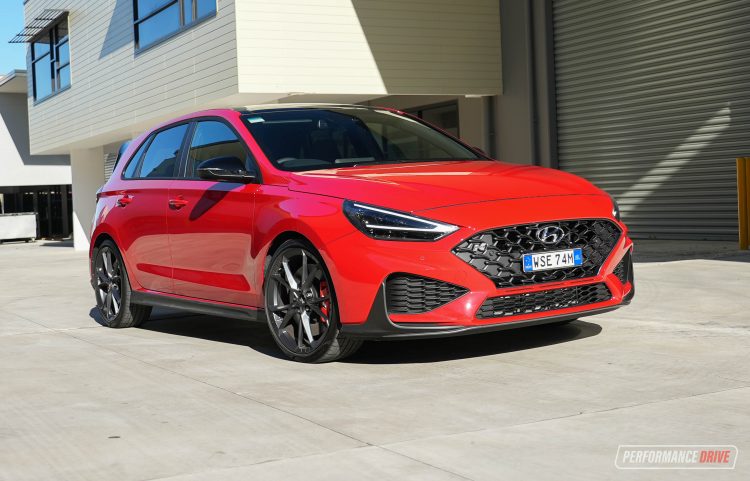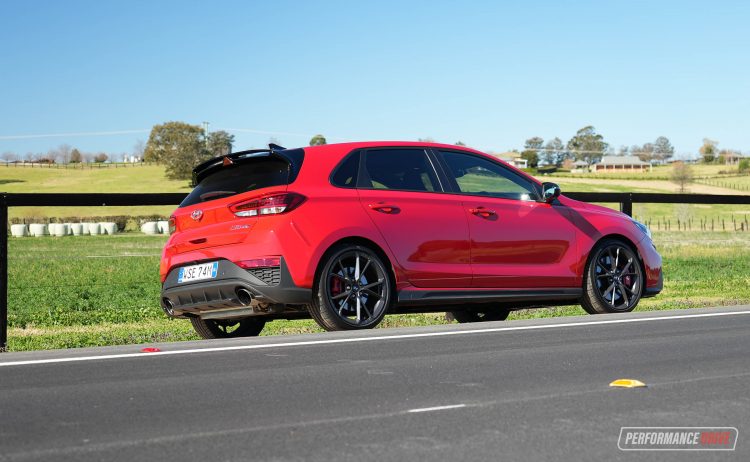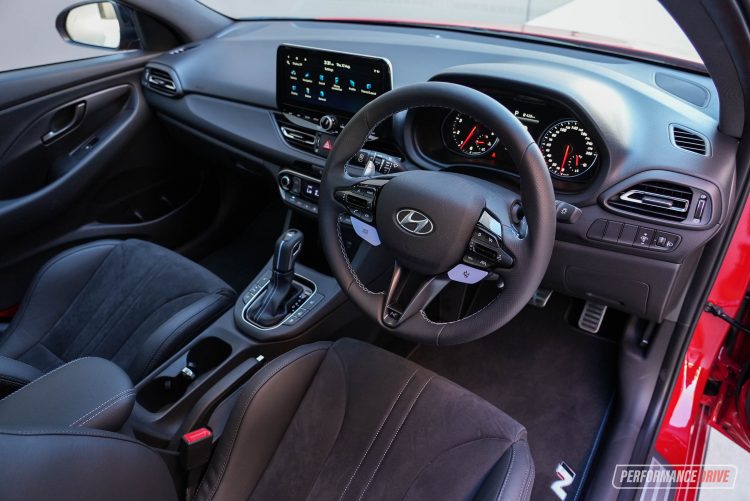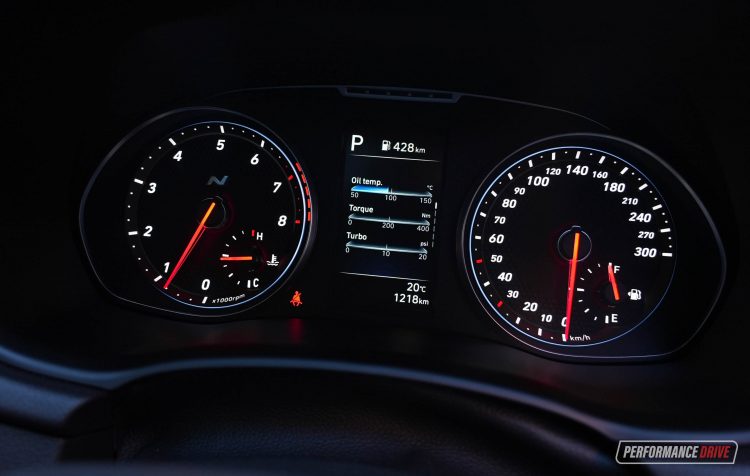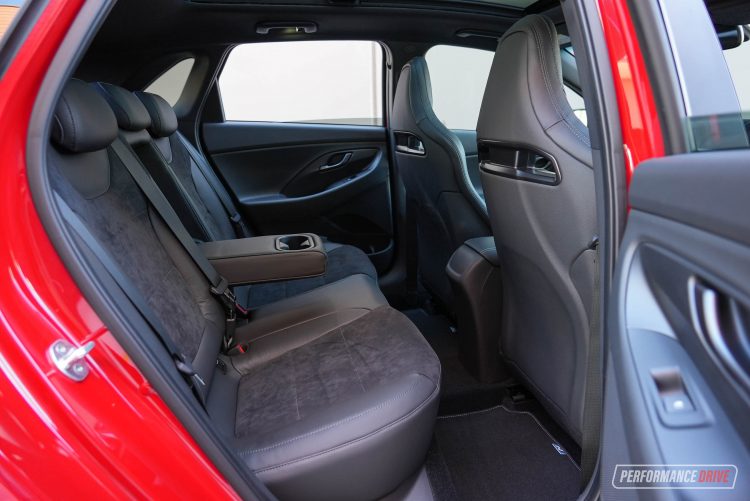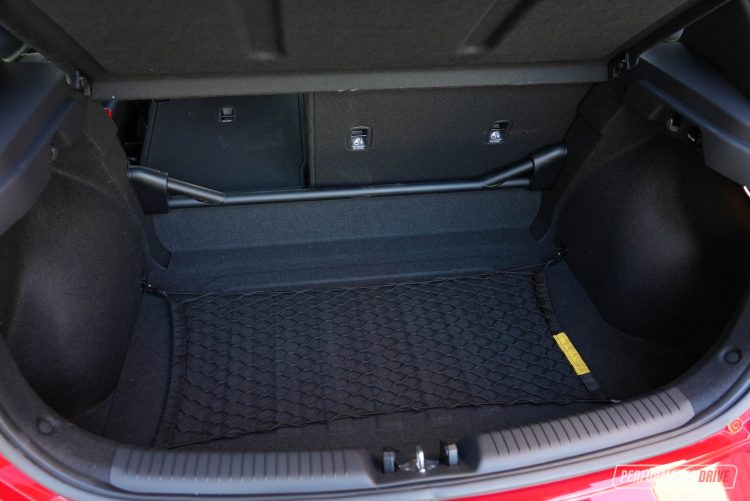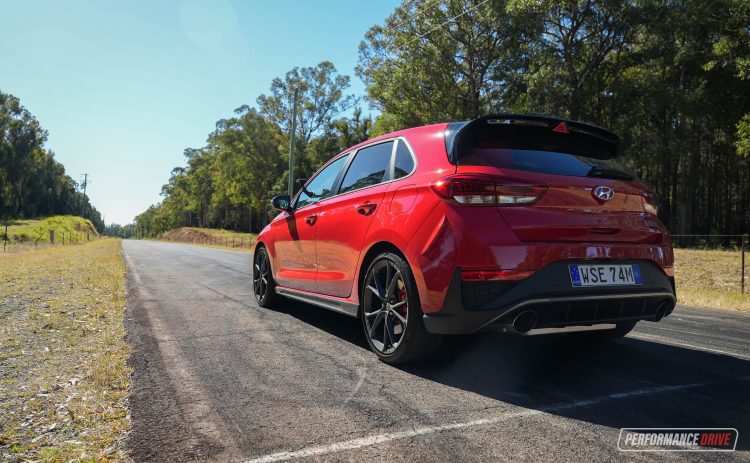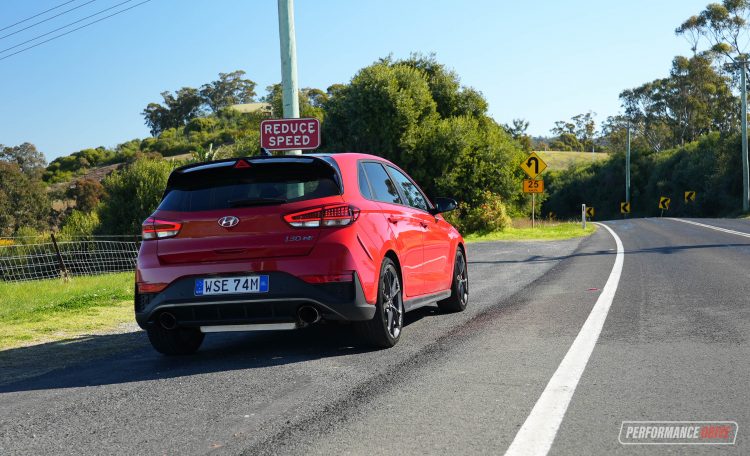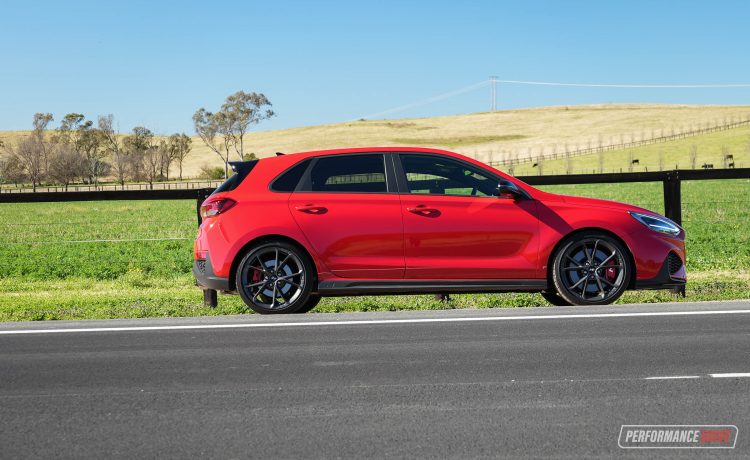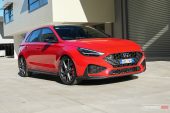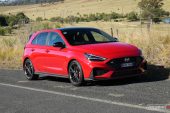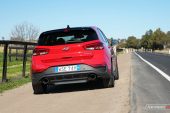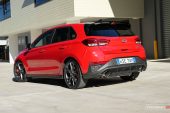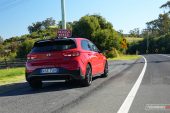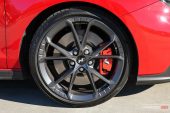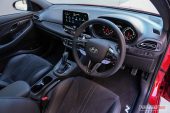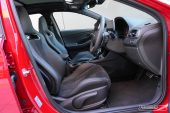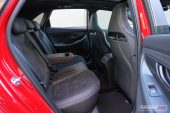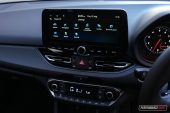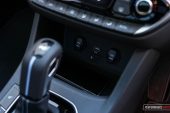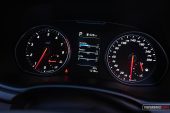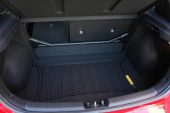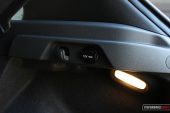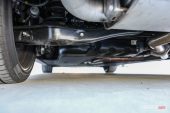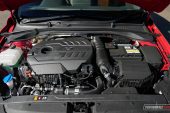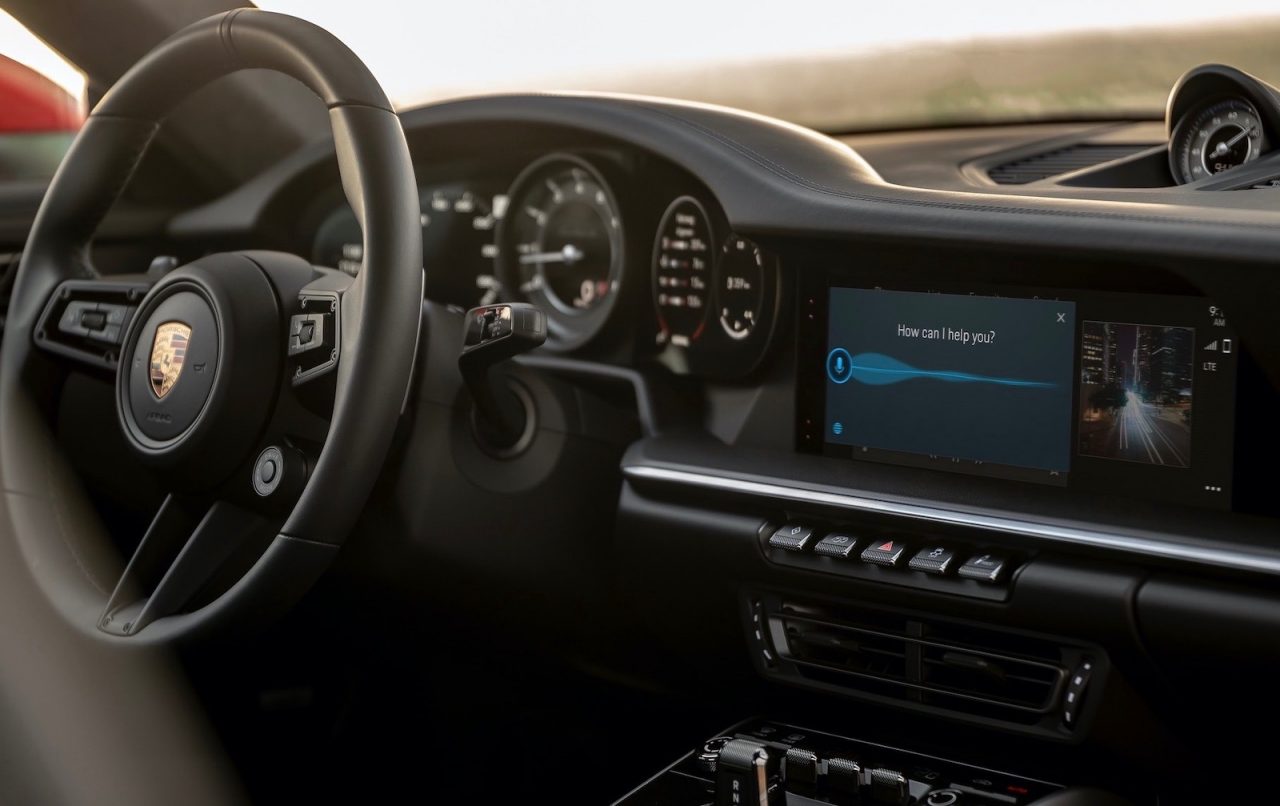Hot hatch fans will be very excited to hear the new 2021 Hyundai i30 N has arrived in Australia. It’s more powerful than the original version, filled with more tech and safety gear, and, for the first time, it’s available with an automatic transmission option. This is looking like a hugely tempting proposition now.
Not that the old model wasn’t appealing. It’s just that now, with a new eight-speed dual-clutch auto available, the i30 N’s market reach is wider than ever. Put it this way, if you loved the i30 N initially but felt left out because you only know how to drive an auto, suddenly this is back in view as a possible acquisition.
The new model is available in two main trim levels – standard and Premium – and with either a six-speed manual or DCT eight-speed auto. There’s also an upper-premium variant that adds an opening panoramic sunroof (only available with the DCT). The car you see here is the latter. Prices start from the following (excludes on-road costs):
2021 Hyundai i30 N hatch manual: $44,500
2021 Hyundai i30 N hatch DCT auto: $47,500
2021 Hyundai i30 N Premium hatch manual: $47,500
2021 Hyundai i30 N Premium with sunroof hatch manual: $49,000
2021 Hyundai i30 N Premium with sunroof hatch DCT auto: $52,000
2021 Hyundai i30 N DCT – THE SPECS
[column width=”47%” padding=”6%”]Engine: 2.0-litre turbo four-cylinder
Output: 206kW@6000rpm / 392Nm@2100-4700rpm
Transmission: Eight-speed dual-clutch auto
Drive type: Front-wheel drive, LSD
Wheels: F & R: 19×8.0, 235/35
ANCAP: Not tested
Tare weight: 1511kg
Power-to-weight: 7.33:1 (kg:kW)
Official fuel economy: 8.5L/100km
Economy during test: 10L/100km
Fuel capacity/Type: 50L/95 RON[/column] [column width=”47%” padding=”0″]Power efficiency: 24.23kW:L/100km
0-60km/h: 2.89 seconds*
0-100km/h: 5.19 seconds*
0-200km/h: 19.86 seconds*
60-110km/h: 3.05 seconds*
1/4 mile: 13.58 seconds at 172.6km/h*
Max acceleration: 0.941g
100-0km/h braking: 2.93 seconds at 37.62 metres*
Max deceleration: -1.211g
Decibel at idle (/Sport mode): 46/51*
Peak decibel at 60-100km/h: 87/90*
Priced from: $52,000[/column][end_columns]
* Figures as tested by PerformanceDrive on the day. Factory claims may be different
2021 Hyundai i30 N DCT – THE PACKAGE
One of the great things about the i30 N, and any hot hatch really, is practicality. This is very much just like a regular i30 inside. All of the controls are where you’d expect them to be, with quick-access buttons on the steering wheel that are also laid out in an orderly fashion. You’ve got twin cup holders in between the front seats, a wireless charging tray for your phone with two 180W charging plugs, as well as a centre console box and arm rest.
It is friendly and accommodating, and not at all overwhelming even on first impressions. In saying that, the i30 hatch is starting age a bit now and you could argue the interior lacks modern design. Some of the materials inside are not the best quality either, as expected for a small non-premium hatch. But some newer competitors are introducing new styles of materials and newer patterns that seem to freshen things up.
Going for the Premium model adds unique ‘N Light’ sports seats in the front (2.2kg lighter than regular seats). These provide ample support in the corners but they are also quite comfortable, with soft cushioning making them suitable for daily commuting. Despite being a ‘premium’ model the front seats are not power-adjustable. We assume this is for weight-saving reasons. However, they do come with seat heating functions, so that’s a bit odd. We do like the old-school twist-knob for recline adjustment though, as this provides an infinite degree of movement. As a result, it’s easy to find a perfect driving position.
The Premium variant also adds rear tinted windows, auto wipers, and front parking sensors and an electro-chromatic rear-view mirror. Is all of that worth it? Well, the N Light seats are definitely very good, but even so the standard ones have always been pretty decent as well. Unless you really want these seats, we’d recommend pocketing the difference and going with the standard variant. In the case of the manual, that’s a saving of $3000. For that you could apply some light tuning, or even buy some proper Sparco bucket seats or something.
All models come with Hyundai’s latest 10.25-inch touch-screen, offering Android Auto and Apple CarPlay, digital radio, and a rear-view camera. The screen also introduces new ‘N’ performance pages, offering displays for acceleration and g-force, as well as controls for things such as the launch control rev limit adjustment (up to 3500rpm).
It is a bit disappointing that the fully digital instrument cluster from the i30 Sedan/Elantra is not brought across here. Although, secretly, we dislike digital gauges anyway. Intricate mechanical dials are much more sophisticated and thus attract a higher appreciation for detail, in our opinion. It’s like comparing a soul-less digital wrist watch to a detailed analogue one. Even so, we can also appreciate the argument about lacking technology and keeping up with modern trends.
Passenger space remains very good for this class, with excellent cabin proportions providing wide and tall door openings for easy access, and decent rear seat legroom. It’s a shame there are no climates vents in the back, but there is a flip-down arm rest with cup holders, and bottle holders in the doors.
Boot space is rated at 381 litres, which is not bad for a small hatch. You can fold down the rear seats to expand the volume to 1287L, but there is a heavy-duty suspension brace running across the back that does impede on sheer versatility.
2021 Hyundai i30 N DCT – THE DRIVE
As for that crackling and popping 2.0-litre turbo engine, it features a new twin-scroll turbocharger (3mm larger compressor wheel, 5mm larger turbine wheel), a larger 6.8L intercooler (up 0.3L), and new pistons. These changes help to increase power by 4kW, and torque is up from 378Nm before (during overboost), to 392Nm.
Across the usual sprints on a private road we clocked a best 0-100km/h time of just 5.19 seconds. That was achieved with the launch control function engaged and the rev limit dialled up to the maximum 3500rpm. Activating launch control isn’t as easy as it could be. You have to be in the N pages within the main touch-screen, and then in the acceleration section and you have to physically hit the ‘launch control’ button. There is a cool-down period before it can be activated in succession.
At 5.19 seconds, this is the quickest-accelerating front-wheel drive car we have ever tested – across 10 years of testing. Taking a look at our large database of real-world performance times, the next-closest hot hatch was the Renault Megane RS Trophy auto, which clocked the sprint in 5.60 seconds. It also features a dual-clutch auto and offers a proper launch control function.
So, in terms of driving excitement, the class-leading acceleration gives it an instant edge over its rivals. Fortunately, the cornering prowess is also top-notch. Hyundai has overhauled the suspension for the new model, applying extra camber on the front axle while also introducing adaptive dampers. The sheer control and adjustability is amazing, and thoroughly entertaining.
For example, you can throw this car into a tight corner aggressively and actually cause the tail to kick out, just using the steering. One might argue perhaps there is a lack of grip. But on the other hand, throttle-off understeer is almost impossible. Instead, it darts in wherever you point it. From there you can apply power and the tail quickly pulls back into line, and there is a tight limited-slip differential to ensure no inside wheelspin.
All models feature forged alloy wheels (3.6kg lighter than the previous wheels), in dark grey, wrapped in similar 235/35 Pirelli P Zero tyres as before – it will be interesting to see how the Elantra N handles, with its 245-section tyres. The steering is highly communicative, providing real-time detailed information on how those tyres are managing at all times, too.
Supporting the enormous fun factor is a firm sense of stability and security when driving. Hyundai has applied larger brakes to the new model, with 360mm front discs (up 15mm), so, on a mountainous road for instance, you can enjoy a spirited drive without having to worry about brake fade or weakening performance. We clocked 100-0km/h in a best of 37.62m. Comparatively speaking, that isn’t such a short distance. But we notice it is repeatable.
As for the new transmission, this is miles ahead of Hyundai’s outgoing seven-speed dual-clutch auto. The gear ratios are evenly spaced, with a good mix of low-down acceleration and torque at low speeds, but also plenty of top end performance. In fact, we clocked 0-200km/h in 19.86 seconds, which is excellent for a full-size hatchback.
The gear changes are pretty much instant, and you get a nice parp in between upshifts. Going through first to second gear can also cause wheelspin if you’re pushing hard. And downshifts are supported by rev-matching. Around town the transmission likes to downshift itself as you brake, preparing for corner exit. This is good as some modern transmissions like to remain in higher gears around roundabouts and so on for fuel-saving reasons, often causing the engine to bog down due to very low revs. Not here. This transmission is clever and seems to be very in tune with what you’re doing.
As this launch event was conducted during coronavirus restrictions, we weren’t able to fully explore the car’s capabilities on a big variety of roads. However, Hyundai Australia says it is looking to host a track event for media as soon as possible.
2021 Hyundai i30 N DCT – THE VIDEO
2021 Hyundai i30 N DCT – THE VERDICT
This is a cracking hot hatch. Honestly, we think it’s the best hot hatch on the market today, in this space. Especially with the new eight-speed auto option. We can’t think of another car that offers more in terms of practicality and versatility, powertrain performance, and sheer fun-driving factor combined.
Yes, prices have climbed over the predecessor, but you are getting more for your money. And yes the exhaust might be too loud for some and the interior might lack in quality in some areas compared with some. As an overall package though, with all positives and negatives combined, and considering its intended purpose and the number of senses it tickles, Hyundai is now the king of this hot hatch class in our opinion.
As always, if you’re thinking about buying a new car don’t forget to click here to speak with our car buying specialists.
